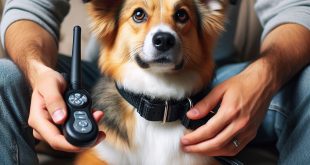The Power of Positive Reinforcement – Positive reinforcement is a powerful training technique used to encourage good behavior in dogs. It involves rewarding your dog for performing a desired action or behavior. The reward can be in the form of food, verbal praise, physical affection, toys, or playtime. In this article, we will discuss the benefits of positive reinforcement, types of rewards, techniques for using positive reinforcement effectively, and common mistakes to avoid.
Table of Contents
Benefits of Positive Reinforcement
Positive reinforcement is a powerful tool for training dogs. It involves rewarding your dog for good behavior, rather than punishing them for bad behavior. Positive reinforcement has many benefits for both dogs and their owners, including:
1. Encourages Good Behavior
Positive reinforcement helps to encourage good behavior in dogs. When a dog is rewarded for a desired behavior, they are more likely to repeat that behavior in the future. This is because the reward reinforces the behavior, making it more likely to occur again.
For example, if you reward your dog for sitting on command, they are more likely to sit on command in the future. This can lead to a well-behaved and obedient dog, which is a joy to be around.
2. Builds Trust
Positive reinforcement can help to build trust between dogs and their owners. When a dog is rewarded for good behavior, they learn to trust their owner and feel more secure in their environment. This can lead to a stronger bond between the dog and their owner.
On the other hand, punishment can erode trust and lead to fear and anxiety in dogs. This can damage the relationship between the dog and their owner, making training more difficult.

3. Reduces Stress and Anxiety
Positive reinforcement can help to reduce stress and anxiety in dogs. When a dog is rewarded for good behavior, they feel a sense of accomplishment and happiness. This can help to reduce stress and anxiety, and improve their overall well-being.
On the other hand, punishment can lead to stress and anxiety in dogs, which can make training more difficult. Punishment can also lead to fear and aggression, which can be counterproductive to training.
4. Provides Mental Stimulation
Positive reinforcement provides mental stimulation for dogs. When a dog is rewarded for good behavior, they are engaged in the training process and using their brains. This can help to provide mental stimulation and prevent boredom, which can lead to destructive behavior.
On the other hand, punishment can lead to a lack of mental stimulation and boredom, which can contribute to destructive behavior. This can be counterproductive to training and lead to a cycle of bad behavior.
5. Humane and Effective
Positive reinforcement is a humane and effective way to train dogs. It does not involve physical punishment or aggression, which can be harmful to dogs. Instead, it encourages good behavior through rewards and positive reinforcement.
Positive reinforcement has been shown to be effective in training dogs, and is widely used by professional dog trainers. It is also a great way to build a positive relationship with your dog, and to enjoy the training process.
In summary, positive reinforcement has many benefits for both dogs and their owners. It encourages good behavior, builds trust, reduces stress and anxiety, provides mental stimulation, and is a humane and effective way to train dogs. By using positive reinforcement techniques, you can effectively train your dog and enjoy a strong bond with your furry companion.
Types of Positive Reinforcement
Positive reinforcement is a powerful training tool that can be used to encourage good behavior in dogs. There are several types of positive reinforcement that can be used to reward and reinforce good behavior. Here are some of the most common types of positive reinforcement:
1. Treats
Treats are one of the most common types of positive reinforcement used in dog training. They can be used to reward dogs for good behavior, such as sitting on command or coming when called. Treats should be small, soft, and easy to chew, so that the dog can quickly eat the treat and return to training.
It’s important to use treats sparingly and to gradually decrease their use as the dog becomes more proficient in their training. Overusing treats can lead to weight gain and other health problems, and can also lead to a dog that is too reliant on treats for good behavior.
2. Verbal Praise
Verbal praise is another common type of positive reinforcement used in dog training. This can include saying “good boy” or “good girl” when the dog performs a desired behavior. Verbal praise can also include a happy and enthusiastic tone of voice, which can reinforce the behavior and encourage the dog to repeat it in the future.
Verbal praise is a great way to reinforce good behavior without relying on treats or other physical rewards. It can also be used in conjunction with treats, to reinforce the behavior even more.
3. Physical Affection
Physical affection is another type of positive reinforcement that can be used to encourage good behavior in dogs. This can include petting, hugging, or even just giving the dog a pat on the head. Physical affection can be especially effective for dogs that are more social and enjoy human interaction.
Physical affection can also be used in conjunction with treats or verbal praise, to reinforce the behavior even more. It’s important to be mindful of the dog’s body language and to respect their boundaries when using physical affection as a reward.
4. Toys and Playtime
Toys and playtime can also be used as positive reinforcement for good behavior in dogs. This can include giving the dog a toy as a reward for performing a desired behavior, or engaging in playtime with the dog after a training session.
Toys and playtime can be especially effective for dogs that are more energetic and enjoy physical activity. It can also be a great way to bond with your dog and to make training more fun and enjoyable for both of you.
In summary, there are several types of positive reinforcement that can be used to encourage good behavior in dogs. Treats, verbal praise, physical affection, and toys and playtime are all effective ways to reward and reinforce good behavior. By using a variety of positive reinforcement techniques, you can effectively train your dog and enjoy a strong bond with your furry companion.
How to Use Positive Reinforcement Effectively
Timing is crucial when using positive reinforcement. The reward should be given immediately after the desired behavior is performed. Consistency is also key, as the dog needs to understand what behavior is being rewarded. Punishment should be avoided, as it can lead to fear and aggression in dogs. Over-rewarding should also be avoided, as it can lead to obesity and other health problems.
Training Techniques using Positive Reinforcement
There are several training techniques that use positive reinforcement. Clicker training is a popular technique that involves using a clicker to mark the desired behavior, followed by a reward. Shaping involves breaking down the desired behavior into smaller steps and rewarding each step. Capturing involves rewarding the dog for performing a desired behavior on their own. Luring involves using a treat to guide the dog into performing the desired behavior.
Common Mistakes to Avoid
Using too much food as a reward can lead to obesity and other health problems. Overuse of verbal praise can also lead to the dog becoming desensitized to the reward. Lack of consistency can also lead to confusion in the dog. Punishing bad behavior instead of rewarding good behavior can also create fear and aggression in dogs, which can be counterproductive to training.
Conclusion of The Power of Positive Reinforcement
Positive reinforcement is an effective and humane way to train your dog. It encourages good behavior, builds trust, and reduces stress and anxiety. By using the right rewards, timing, and consistency, you can effectively train your dog using The Power of Positive Reinforcement techniques.
FAQs
1. Can positive reinforcement be used for all dogs?
Yes, positive reinforcement can be used for all dogs, regardless of their age, breed, or behavior. However, some dogs may require more patience and training than others.
2. How often should I reward my dog for good behavior?
It is important to reward your dog immediately after they perform a desired behavior, and to be consistent in your rewards. However, over-rewarding can lead to obesity and other health problems, so it is important to find the right balance.
3. Is it okay to use treats as a reward?
Yes, treats are a common form of reward for dogs, as they are highly motivated by food. However, it is important to use healthy treats in moderation to avoid overfeeding.
4. What should I do if my dog doesn’t respond to positive reinforcement?
If your dog is not responding to positive reinforcement, it may be helpful to try a different training technique, or to seek the help of a professional dog trainer.
5. How long does it take to see results from The Power of Positive Reinforcement training?
The time it takes to see results from positive reinforcement training can vary depending on the dog’s age, breed, and behavior. However, with patience and consistency, most dogs can be effectively trained using positive reinforcement techniques.
 Treat For Dog – Brain Training for Dogs, Dog Training & Obedience Discover Treat For Dog and get your pup on the path to smarter, happier, and healthier living with brain training for dogs.
Treat For Dog – Brain Training for Dogs, Dog Training & Obedience Discover Treat For Dog and get your pup on the path to smarter, happier, and healthier living with brain training for dogs.




